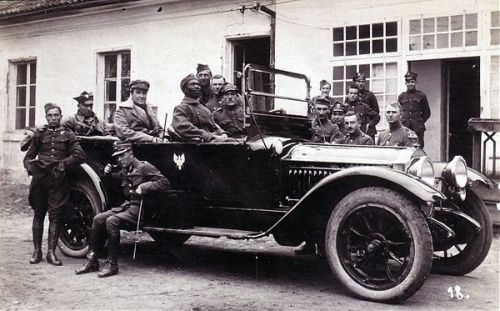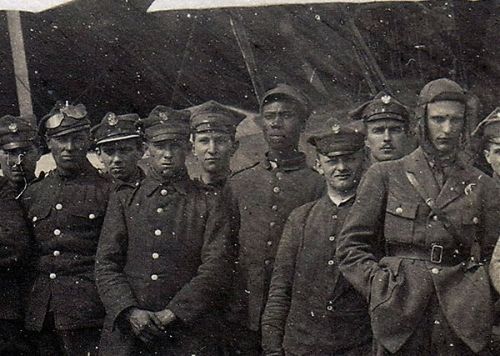#polish soviet war
1920 05 Ucrania, carga de la caballería roja - Steve Noon
Ruptura del frente por el Primer Ejército de Caballería, Mayo 1920
La llegada del Primer Ejército a Caballo de Budyonny a los alrededores de Uman en mayo de 1920 jugó el papel central en la derrota del ejército polaco en la Ucrania de la orilla derecha. Los ataques iniciales a finales de mayo de 1920 fueron repelidos con grandes pérdidas por ambos bandos. Después de un cambio de tácticas para bombardear las posiciones polacas con mças potencia de fuego, el Primer Ejército de Caballería, pudo finalmente romper las principales líneas de defensa el 5 de junio de 1920, precipitando la derrota del Tercer Ejército Polaco de Kiev. La caballería bolchevique, basada principalmente en regimientos cosacos, luchó casi enteramente a caballo y evitó la táctica de combate desmontado de los dragones. Llevaban uniformes cosacos tradicionales, aunque a muchos les gustaba el nuevo gorro bolchevique de tela gruesa (shlem sukonniy) que se llamó popularmente “Budionovka” en honor a Budionny debido a su asociación con el Primer Ejército a Caballo. Sus armas eran principalmente el sable y la pistola, aunque algunos usaban carabinas y otras armas.Una de las innovaciones tácticas durante las guerras civiles rusas fue el uso de la tachanka. Este era un carro ordinario de cuatro ruedas, tirado por caballos que llevaba una sola ametralladora Maxim. Durante los asaltos, las tachanka se colocaban delante para crear una base de potencia de fuego concentrada para apoyar los ataques a caballo. Durante las operaciones defensivas, podían servir en la retaguardia para desalentar la persecución del enemigo. El Primer Ejército a Caballo tenía agregados trenes blindados y auto-ametralladoras para apoyo de fuego. También había un destacamento de aviación, que sufrió grandes pérdidas en la fase inicial de la campaña de Kiev, por lo que desempeñó un papel mínimo en los combates posteriores.
Post link

A Belarusian cartoon lamenting the partition of Belarus between the Soviets and the Poles in the Treaty of Riga; note that the original Soviet proposals would have placed MInsk (center) on the Polish side.
March 18 1921, Riga–The Soviets and Poles had concluded an armistice in October, but a formal peace treaty had proved elusive. The Soviets, eager to normalize their relations with their neighbors, were fine with drawing the border roughly along the armistice line. Many of the Polish negotiators, however, did not want to annex so much eastern territory whose inhabitants were mostly Belarusians and Ukrainians, and the Polish delegation rejected the offer, much to Piłsudski’s chagrin.
By March, Lenin, who had other more pressing internal concerns with Kronstadt, strikes, and peasant unrest, pressed for a resolution to the negotiations, and on March 18 a treaty was signed in Riga. A border was agreed to about 60 miles west of the original Soviet proposal (but still around 150 miles east of the modern Polish frontier). Most notably, this meant that Minsk would return to Soviet hands. Poland would also receive 30 million rubles in compensation for Russia’s hundred-year occupation of the country.
October 16 1920, Riga–After defeats on the Vistula and the Niemen, the Soviets were ready to sue for peace with Poland before losing any more territory. Likewise, Poland had learned their lesson from their misadventures in Ukraine earlier in the year, and wanted peace from a position of strength, without overextending themselves too far once again. On October 12, the Poles and Soviets agreed to an armistice. However, it would not go into effect for several days, and both sides spent the last few days of fighting securing as much territory as they could, as the armistice line could very well determine the ultimate negotiated frontier. The Poles still had the upper hand here, and on October 15 they captured Minsk from the Soviets. The ceasefire entered into general effect on the 16th, though limited fighting continued until the 18th in some areas.
The ceasefire, however, did not apply to Poland’s allies–Petliura’s Ukrainians and smaller forces of Belarusians and Whites. However, these forces found themselves highly outnumbered without explicit Polish support, and these groups were largely defeated and forced into exile by the end of November.

Polish soldiers in Vilnius.
October 9 1920, Vilnius–After the Polish victory outside Warsaw, the Poles could once again turn their attention back to Lithuania, where Polish ambitions had been checked a year before. In early September, Poland protested to the League of Nations about Lithuania’s complicity in the Soviet invasion of Poland, and the League attempted to mediate the ongoing dispute between the two countries. While negotiations were proceeding, Polish forces brushed aside Lithuanian troops to outflank Soviet positions on the Niemen. The annoyed the League, who demanded a ceasefire between Poland and Lithuania.
On October 7, a ceasefire was agreed to, along with a demarcation line between Polish and Lithuanian troops. However, its eastern progression abruptly ended at Bastuny, on the railway line leading south from Vilnius, as Poland demanded freedom of action further east to fight the Soviets (although ceasefire negotiations between Poland and the Soviets were well underway).
Piłsudski wanted to take Vilnius for Poland, but realized this would be unacceptable to the League. He instead arranged for Lucjan Żeligowski, a division commander, to “mutiny” and seize the city, taking inspiration from D’Annunzio’s seizure of Fiume in 1919 with covert backing from Badoglio. The Lithuanians, outnumbered by Żeligowski’s forces and the majority Polish population of the city, fell back, and the city came under Żeligowski’s control on October 9. Three days later, Żeligowski declared the existence of the Republic of Central Lithuania, which he would rule as an effective Polish puppet state until Poland annexed it two years later.
Sources include: Margaret MacMillan, Paris 1919; Prit Buttar, The Splintered Empires.
African volunteers in the Polish army during the Polish-Soviet War (1919-1921). Images via Afryka.org andMuzeum Lotnictwa.
There’s sadly not much of surviving records about them. One newspaper article specifies that name of one of them was “Dżek” (probably Jack) and he came from South Africa (or just southern parts of the continent). Most likely all of them acquired Polish citizenship before joining the Polish troops. Pictures show members of the 12th Air Intelligence Squadron (12. Eskadra Wywiadowcza).
The Polish-Soviet conflict broke out just after the end of the World War 1 in the Eastern Europe. It attracted many unexpected volunteers from around the world, who fought against the Bolshevism alongside the newly freed Poland - country that had just regained independence and returned to the map of Europe after over a century of the foreign occupations [see: Partitions of Poland]. The war largely determined the Soviet-Polish border for the period between the two World Wars.
Post link





